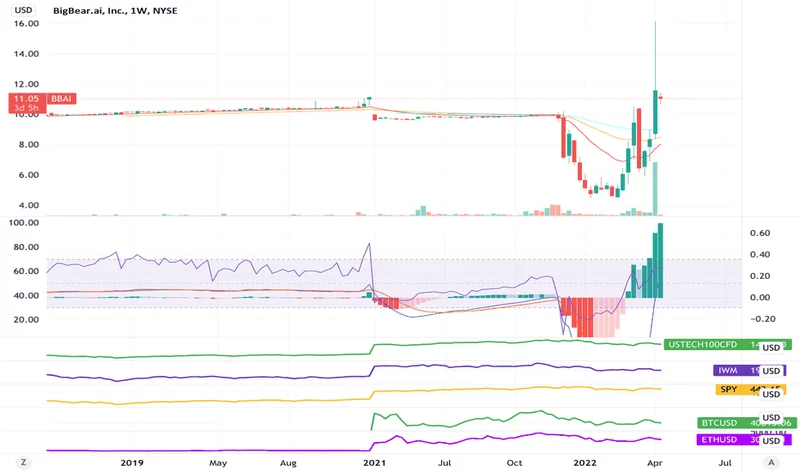BigBear.ai's 422% Rally: A Clinical Look at the Numbers Behind the Noise
When a stock posts a 422% gain over twelve months, the market has clearly priced in a story of profound transformation. For BigBear.ai (BBAI), that story is compelling: a nimble, mission-focused AI company poised to capture a slice of the massive government spending on defense and intelligence. The recent 80% year-to-date surge, punctuated by high-profile deals with the U.S. Navy, seems to confirm the narrative. This has prompted headlines like BigBear.ai Stock Soars 80% in 2025 – Is This AI-Defense Gem the Next Big Thing? But a clinical examination of the underlying financial data reveals a stark and troubling disconnect. The market is cheering a story that the company’s own income statement has yet to validate.
The dissonance begins with the most recent quarterly results. For its second quarter, BigBear.ai reported revenue of $32.47 million. This wasn't just a miss against analyst estimates of $41.18 million; it represented an 18.3% decline year-over-year. A company at the heart of the AI revolution, a sector defined by explosive growth, is seeing its top line shrink. Management subsequently lowered its full-year revenue guidance, a move that typically sends a stock into a tailspin. Instead, BBAI has largely shrugged it off, buoyed by announcements like the UNITAS 2025 naval exercise. This presents a fundamental conflict: is BigBear.ai a growth story fueled by cutting-edge contracts, or a business struggling with execution? The numbers, right now, point squarely to the latter.
Deconstructing the "Mini-Palantir" Narrative
Much of the bullish thesis for BigBear.ai hinges on its comparison to Palantir, the titan of government data analytics. The logic is seductive: BBAI is a smaller, more agile version with a lower stock price, offering ground-floor access to the same secular trends. This analogy, however, collapses under the slightest scrutiny of their business models. Palantir built its empire on scalable, high-margin software platforms. BigBear.ai, by contrast, appears to operate more like a traditional government IT contractor, delivering custom, mission-specific solutions.
The proof is in the margins. Palantir consistently reports gross margins in the neighborhood of 80%. BigBear.ai’s Q2 2025 gross margin was just 25%. I've analyzed hundreds of government contractors and tech firms, and this particular data point is the one I find genuinely puzzling. A 25% margin is what you'd expect from a low-tech services provider, not a company pitching "mission-ready AI" and a proprietary platform called ConductorOS. This suggests that BBAI’s revenue is derived from labor-intensive, one-off projects rather than a scalable, repeatable software product. It’s not a "mini-Palantir"; it’s an entirely different kind of animal, and one with a far more challenging path to profitability.
The company’s balance sheet does offer a cushion. With nearly $391 million in cash and a contract backlog of around $380 million, BigBear.ai isn't facing an imminent crisis. But a backlog is only as good as the profits it generates. A backlog of low-margin work provides revenue visibility, but it doesn't solve the core business model problem. What does it matter if you have a pipeline of work if that work doesn't produce meaningful profit?

A Battle Between Sentiment and Financials
This brings us to the stock itself, which seems to operate in a universe entirely separate from the company’s financial filings. The current valuation is a testament to the power of narrative in today's market. Investors are buying the promise of AI, the allure of defense contracts, and the potential for a short squeeze. That last point is critical. With short interest standing at an extremely high 21.3% of the float, a significant portion of the market is betting heavily against the company. This creates a volatile feedback loop where any positive news can trigger panicked buying from short-sellers looking to cover their positions, launching the stock higher irrespective of fundamentals.
The analyst community reflects this confusion. The consensus rating is a "Hold," with an average price target hovering around $6.00. Yet, as of early October, the stock was trading well above $7.00. This is an unusual situation. It means that, on average, Wall Street analysts believe the stock is overvalued, even as some of their colleagues maintain "Buy" ratings with higher targets (the highest being $8.00). This isn't a sign of conviction; it’s a sign of a deeply divided view on whether the story or the numbers will win out.
Further muddying the waters is the insider activity. The company’s CFO recently sold a block of shares (a transaction totaling $64,082.30). While not a catastrophic sum, it was a nearly 4% reduction in his holdings. Insider selling is never a vote of confidence, especially in a company whose stock price relies so heavily on faith in its long-term vision. The institutional ownership is also remarkably low at about 7.5%, suggesting that the big, patient money has largely remained on the sidelines. The rally appears to be driven by retail sentiment and momentum traders, not fundamental conviction from the world’s largest asset managers.
The Valuation Is Untethered from Reality
Ultimately, the case for BigBear.ai is not an investment thesis; it's a speculative bet. This view is echoed by analyses that characterize it as a Wild BigBear.ai Stock (BBAI) Presents Civilized Spec Options Trade. It's a bet that the narrative will continue to overpower the weak financial performance. It's a bet that new, high-profile contracts will distract from shrinking revenues and razor-thin margins. And it's a bet that a massive short position will provide the fuel for the next leg up.
But speculation is not a sustainable foundation for value. At some point, a company must deliver the financial results to justify its market capitalization. BigBear.ai has yet to do so. The stock’s performance is a fascinating case study in market psychology, but the numbers paint a picture of a business with fundamental challenges. The disconnect between the two is a chasm, and investors should be wary of what happens when the narrative fuel runs out.










